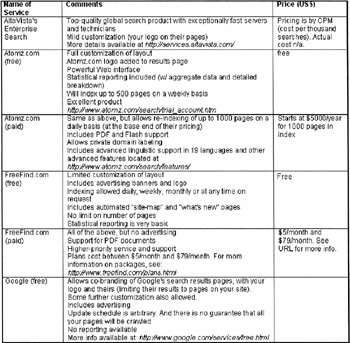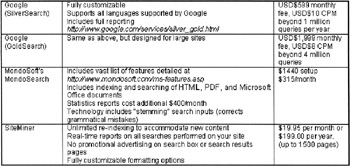Software and Tools
There are many companies that create software and tools for intranet sites. Most of their products relate to the functionality options detailed in the Needs Analysis section above. These products are generally provided as hosted solutions for companies that don't have the technical resources or budgets to build proprietary solutions or make outright software purchases.
Many of these items are covered in some detail earlier in this chapter. One that does need special attention, however, is Search. This is a functionality that is almost always a priority in a Project Scope Document, is very difficult to implement well, and can cause some sincere complications for a development team.
Search Solutions
The 'search' function on a web site can be a very valuable resource to users. It adds a high degree of usability because it allows users to look for the information they're actually looking for, instead of the information your information architects thought they would be looking for when they designed your site's navigation schema. Even the most capable team of human factor engineers (usability experts) will never be able to take into account all your users' information needs in respect to specific words or phrases. That's why having a search function is a really good idea.
Unfortunately, there are numerous circumstances in which a company will be unable to simply include a search function on their intranet site when the need for one arises. The technical complexity inherent in searching for keywords or phrases embedded in HTML is often beyond the level of technology used in the creation, implementation, and maintenance of a site.
Many web sites are static, meaning that each of its pages is an individual file where the content (text and images) is integrated with the formatting (page layout, font information, text size, image alignment, etc.). There are various degrees of dynamic templating and scripting that can be implemented to make maintenance of individual pages' content and an entire site's graphical "look and feel" more efficient, but any site that does not store its content in a database is still a static site at its core. That means it's a series of individual digital pages that have only superficial relationships to each other and searching them from within the site will be impossible.
In order to make a site searchable in this scenario, there are two possible solutions:
-
Invest what may amount to substantial resources migrating your site onto a database-driven platform that will allow your developers to create a search function. This will typically involve developing or purchasing a content management system that includes a Boolean search capability (allows use of 'and', 'or', 'not', and other advanced operators to fine-tune search requests).
-
Outsource your search functionality to a Remote Site Search Service that will place your search engine on a web server which is distinct from the one where your web site is hosted. This will allow you to let someone else handle most of the technical issues, and allow you to likely realize substantial savings over solution #1.
If you're interested in learning more about the first option, you should read Chapter 8 on Content Management Systems.
The Remote Site Search Service option mentioned briefly in solution #2 above encompasses a wide choice of services and service providers. The different packages vary in cost from free to very expensive and have numerous value-added options that were implemented in efforts to distinguish themselves from their competition.
All Remote Site Search Services rely on the same basic precept: they function like any of the major search engines, but limit their results to those found on the pages specified for indexing by their clients. Essentially, the remote searcher's "web spider" crawls your site and stores your pages' information in an indexed database on their server. When one of your users enters a query from a search form on your site, the query goes by HTTP to the search provider. The search provider looks up the query in their index, formats the results in a format specified by you (which is likely to be derived from your existing web templates), and then displays them on their web site. The results' links, when selected, take the user back to the appropriate page on your site.
Note that, if the results page is formatted properly, this process can be hidden from your users and they will never be made aware of the fact they're leaving and returning to your site during their searches.
Where the service providers diverge in their offerings is in their core technology, their features, and their pricing. Some service providers offer straightforward search capability (simple text and phrases only) while others provide a more complex search capability that includes date-ranging, relevance ranking, and proximity operators (NEAR). As well, a key feature that is very valuable to most site administrators is the availability of statistical reporting on search usage that includes aggregate data and allows for a better ongoing understanding of what users are looking for on a site.
In regard to pricing, the range is significant, from free to tens of thousands of dollars (US) per month. An overview of some of the services is below. Following that, there will be a recommendation and a brief section on limitations.
Remote Site Search Service Options


Limitations
While there are numerous benefits to using a Remote Site Search Service (such as no load on your servers and the features mentioned above), there are some drawbacks to consider as well:
-
Your Internet site will be dependent on an outside service. If that service is under peak-period strain of overuse, the response time may be slow.
-
Some RSSS providers will have their own features which may not be customizable to the rather special requirements of your intranet system.
-
If your data changes frequently (hourly or daily in some cases), the results will not automatically be updated, unless your plan includes frequent updates.
-
There is sometimes a limit on capacity where a remote search service has a page limit from 150–5000 pages in their index. If your intranet is larger than that, it might not be entirely searchable. You'll need to evaluate the packages offered by your chosen provider and compare that with the estimated launch size of your intranet site (the number of pages and documents that will exist) and the projected size over the medium and long term. Note that this may substantially affect the cost of this service.
-
You must pay a regular fee that is not an investment in your own core technologies.
EAN: 2147483647
Pages: 124